
Articles written by Joel Theriault for InterPares Newspaper 2005 - 2006 Season

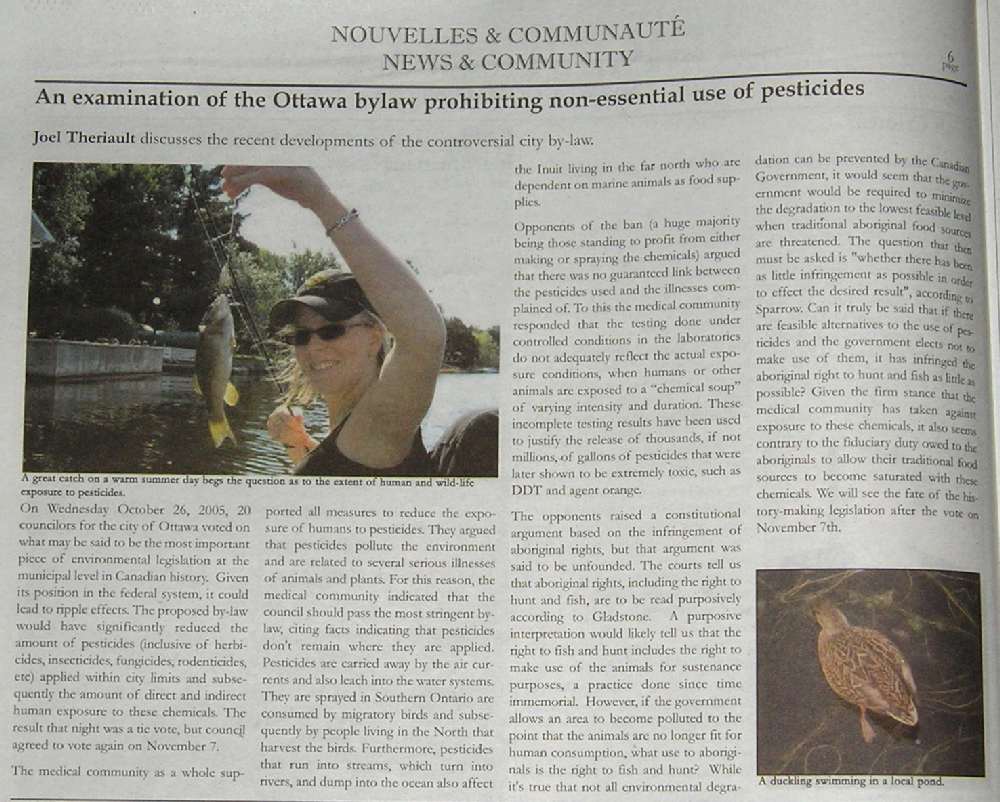
NOTE : The editing staff changed the context of the article ... and I didn't have an opportunity to view it before it was published. No one raised an aboriginal arguement, though one existed.
NOTE : The following article was prepared, though never published.
Title: An Examination of the Ottawa Bylaw prohibiting Non-essential Use of Pesticides Part II
Byline: Joel Theriault revists Ottawa Pesticide by-law with a northern focus.
By: Joel Theriault
*Correction to Part I of this article in the November 2005 issue of Inter Pares: no constitutional aboriginal argument has been raised.
Update: Ottawa city council rejected a city by-law (voting 11 to 9) aimed at prohibiting non-essential uses of pesticides within city limits. However, the debate regarding the legality of pesticide use doesn't necessarily end at that point. Another possible tool which may assist anti-pesticide advocates is the Ontario Pesticides Act (the Act) itself, especially section 11(3) dealing with the permits issued to apply pesticides. Pesticide is a broad term which includes herbicides, rodenticides, fungicides, insecticides, and other substances used to kill "pests."
S.11(3)(c)-(g) of the Act relate to health, safety, and concern for local environmental factors. The faltering point in the last vote was the mixed scientific evidence and lack of 100% proof that the pesticides being used were leading to health and environmental problems. The foregoing analysis is in regards to the forestry operations of Northern Ontario, but an analogy may be drawn to pesticide application in an urban context. Other criteria which will be analyzed below focus on the availability of alternatives to accomplish the same objective.
11(3)(h) “A different method of control or extermination will or will likely be substantially as effective as the proposed extermination for which a permit is required under section 7 and will or will likely cause less impairment of the environment, if any, for any use that is being or is likely to be made of it or less harm to or adverse effect, if any, on any plant or animal life, humans or property;”
11(3)(i) “The use of the pesticide will not be or will not likely be effective or necessary to carry out the extermination.” R.S.O. 1990, c. P.11, s. 11.
When read together, the two criteria seem to indicate that if there are alternatives to herbicides which will "likely be substantially as effective" and "will likely cause less impairment of the environment," the use of herbicides are not "necessary" and a permit should not be issued for pesticide application. Read at face value, using the word "necessary" in 11(3)(i) would seem to indicate that if there are any alternatives to pesticides that will be "substantially as effective," the director of the Act would be obliged to revoke any permit allowing for the pesticide application.
Given the high rate of unemployment in Northern Ontario, it may be a difficult proposition to say that the use of pesticides is actually necessary given the fact that the same ends can be reached through manual thinning (among other non-herbicide methods) to eliminate competition for newly planted seedlings.
According to a Labour Force Survey Statistical Report provided by the Northern Ontario Area Economist, for the month of November 2005, there were 400,400 (5.8%) people on unemployment insurance in the province of Ontario. Northern Ontario accounted for 22,500 (6.0% unemployment in the region) of the total during this same period. Site specific locations such as the greater Sudbury area had 6,100 unemployed persons (7.5%) and the Thunder Bay area had 3,500 unemployed persons (5.4%) during November. With so many willing workers in Northern Ontario on unemployment, and manual thinning having been proven to be as effective as the use of herbicides, it is uncertain whether it is in fact "necessary" to use these chemicals in public forests.
However, The Ministry of Environment (MOE) seemingly does not define "necessary" as “without alternatives” but rather as "most cost effective." According to Don Mitchell of the MOE, Thunder Bay branch, the term "substantially as effective" really means that when competing methods are roughly equivalent based on cost effectiveness, the Minister can refuse to issue a permit for the practice which he feels to be more environmentally damaging. Without arguing the merits of this definition (failing to include externalities like the possible health effects to the residents of N. Ontario), it is still seemingly not "necessary" to use pesticides on public forests so long as it could be demonstrated that other methods which met the same result wouldn't cost more money.
The starting point for this argument in a forestry context is at the renewal fees paid by forestry companies before the harvest occurs. A trust fund system was created to ensure that monies needed for renewal would be available even if the forestry company went out of business. Where no renewal is needed (depending on the species of tree harvested and method of harvest) there is no requirement to pay into the trust fund and likewise no requirement to spray the area with pesticides. If renewal is needed, the forestry company pays into the renewal trust fund and, after the harvest, applies to the trust fund to be compensated for expected renewal expenses.
Forestry companies are obliged to renew the forest if it will not naturally regenerate (dependent on forest composition and method of harvest) but are not expected to reap a profit from this portion of the forestry process. As such, there would seem to be no reason why forestry companies would fight against a delegation of renewal obligations to a 3rd party. Some might argue that the government of Ontario is the ideal 3rd party to take over these renewal obligations because it already has a major payroll of people without any work to do – those on unemployment insurance.
Because forestry companies are currently in charge of regeneration, they already have a large part of the required infrastructure established, and the government of Ontario could contract for these services with monies from the renewal trust fund. Additional required support and manpower could be provided by those on unemployment insurance.
In conclusion, even assuming that the judicial system was ready to accept the proposition that the term "necessary" meant "cost effective," it seems as though a valid argument could be raised that the use of herbicides in northern forests is not legitimate. Key to this argument would be that the current system fails to utilize its resources efficiently. Implicit in the understanding of being "necessary" (most cost effective according to MOE) is that all avenues and resources will be judicially used.
In terms of an aboriginal rights argument, failing to use these resources efficiently may beg the question, "whether there has been as little infringement as possible in order to effect the desired result" (Sparrow). If the use of pesticides is not truly required to achieve the result of eliminating competing plant species, and techniques such as manual thinning are less likely to irreparably damage traditional food sources, an aboriginal litigant may be able to convince the court that the use of pesticides is not justified as it does not “minimally” impair the right to fish and hunt for sustenance.

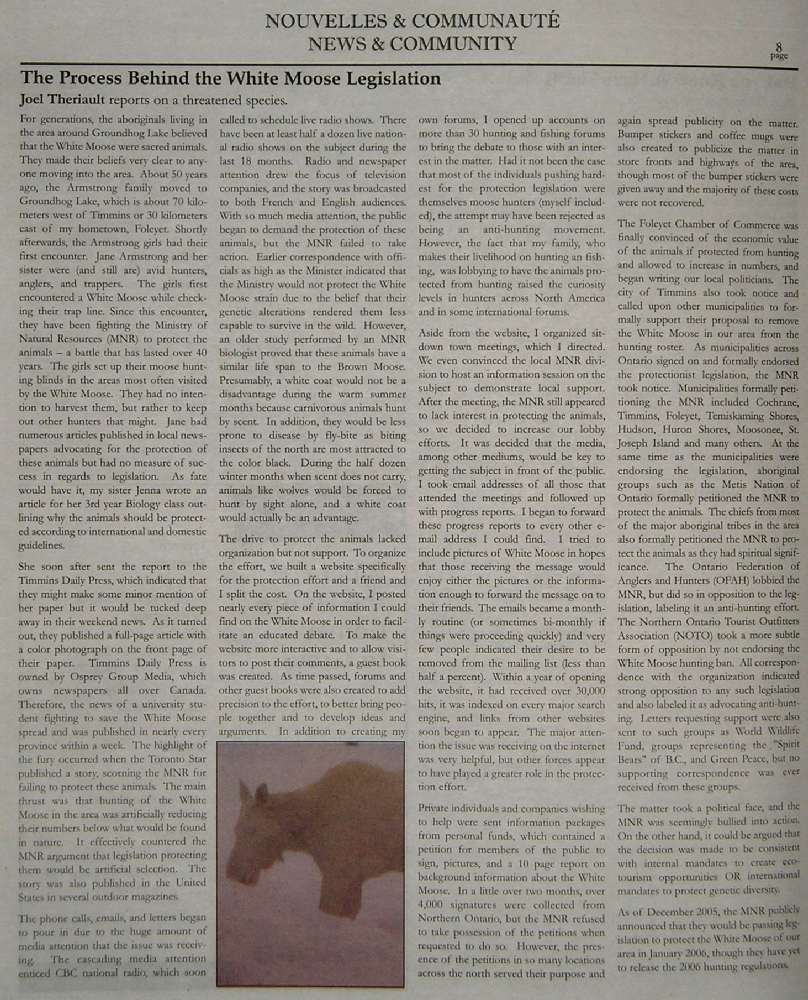
Extended Version - Easier Reading : The abbreviated process behind the white moose legislation
The (abbreviated) process behind the White Moose Legislation
For generations, the aboriginals living in the area around Groundhog lake believed that the white moose were sacred animals. They made their beliefs very clear to anyone moving into the area. About 50 years ago, the Armstrong family moved to Groundhog Lake (which is about 70 kilometers west of Timmins or 30 kilometers east of my home town, Foleyet) and shortly after the Armstrong girls had their first encounter. Jane Armstrong and her sister were (and still are) avid hunters, anglers, and trappers. The girls first encountered a white moose while checking their trap line. Since this encounter, they have been fighting the Ministry of Natural Resources to protect the animals, a battle lasting over 40 years. The girls set up their moose hunting blinds in the areas most often visited by the white moose. They had no intention to harvest them, but rather to keep out other hunters that might. Jane had numerous articles published in local newspapers advocating for the protection of these animals, but with no measure of success in regards of legislation. As fate would have it, my sister Jenna wrote an article for her 3rd year biology class outlining why the animals should be protected according to international and domestic guidelines. She soon after sent the report to the Timmins Daily Press, who indicated that they may make some minor note of the paper, tucked deep away in their weekend paper. As it turned out, the following weekend was evidently devoid of any "newsworthy" material, so they published a full page article with color photograph on the front page of their paper. The Timmins Daily Press is owned by Osprey Group media, which owns newspapers all over Canada. Therefore, the news of a university student fighting to save the white moose spread and was published in nearly every province within a week. The highlight of Canadian newspaper articles occurred when the Toronto Star published a story, scorning the Ministry of Natural Resources for failing to protect these animals. The main thrust was that hunting of the white moose in the area was artificially reducing their numbers below what would be found in nature. It effectively countered the MNR argument that legislation protecting them would be artificial selection. The story was also published in the United States in several outdoor magazines. The phone calls, emails, and letters began to pour in with the huge amount of media attention the issue was receiving. The cascading media attention enticed CBC national radio and they soon called to schedule live radio shows. There have been at least half a dozen live national radio shows on the subject during the last 18 months. Radio and newspaper attention drew the focus of television companies, and the story was broadcasted to both French and English audiences, though I don't believe it extended beyond Northern Ontario. With so much media attention, the public began to demand the protection of these animals, but the Ministry of Natural Resources refused to take any action. Earlier correspondences with officials as high as the minister indicated that the organization would not protect the white moose strain, due to the belief that their genetically alterations rendered them less capable to survive in the wild. However, an older study performed by an MNR biologist proved that these animals have a similar life span to brown moose. Presumably, a white coat would not be a disadvantage during the warm summer months because carnivorous animals are hunting by scent. In addition, they would be less prone to disease by fly-bite as biting insects of the north are most attracted to the color black and least attracted to the color white. During the half dozen winter months when scent doesn’t carry, animals like wolves would be forced to hunt by sight alone, and a white coat would actually be an advantage. Also interestingly, photo's of the white moose from the spring months when the animals are molting (such as the one attached which was found at the MNR website) reveal that the animals have nearly black skin (similar to polar bears) under their white coats.
The drive to protect the animals lacked organization, but certainly not support. To organize the effort, we decided that a website should specifically be built for the protection effort. A friend and I agreed to split cost of creating the website. It initially looked terrible, but was generally well received by the public. Maybe they understood that a no money lobby group was behind the effort, or maybe they were just happy to see someone working towards the goal. On the website, I posted nearly every piece of information I could possibly find on the white moose, with the intention of facilitating an educated debate. To make the website more interactive and allow visitors to post their comments, a guest book was created. Forums and other guest books were also created as time passed to add precision to the effort, and attempt to better bring people together and develop ideas and arguments. In addition to creating my own forums, I opened up accounts on more than 30 hunting and fishing forums, to bring the debate to those with an interest in the matter. Had it not been for the fact that most of the individuals pushing hardest for the protection legislation were themselves moose hunters (including myself), the attempt would have been flatly rejected as another anti-hunting movement. However, the fact that my family, which is entirely financially dependent on hunting and fishing for a livelihood, was lobbying to have the animals protected from hunting raised the curiosity levels in hunters across North America and in some international forums.
Aside from the website, I organized sit down town meetings, which I (by default because no one else wanted to) ended up directing. We even convinced the local MNR to host an information session on the subject. I indicated that I desired to make a documentary of the meeting, but was told that the MNR would not be participating in the PUBLIC meeting if I was taping it. During the meeting, it was very clear that the MNR had absolutely NO interest in protecting the animals and that we would have to lobby very hard to have anything accomplished. It was decided that the media, among other mediums, would be key to getting the subject in front of the public. I took email addresses of all those that attended the meetings and followed up the meetings with progress reports. Realizing the power of email, I soon after began to collect email addresses from many sources. I began to forward on these progress reports not only to those attending the meetings but to every other email address I could find. I tried to include pictures of white moose with every email with the hope that those receiving the message would enjoy either the pictures or the information enough to forward the message on to their friends. The emails became a monthly routine (or sometimes bi-monthly if things were proceeding quickly) and very few people indicated their desire to be removed from the mailing list (less than half a percent). The email campaign was doing well and within a year of opening the website, we had received over 30,000 hits and was indexed on every major search engine. The content was extremely unique and links from other websites began to appear. The major attention the issue was receiving on the internet did wonders, but I believe other forces played a greater role in the protection effort.
Private individuals and companies wishing to help were sent information packages (again from personal funds) which contained a petition for members of the public to sign, pictures, and a 10 page report on background information about the white moose. In a little over two months, over 4,000 signatures were collected from Northern Ontario, but the MNR refused to take possession of the petitions when requested to do so. However, the presence of the petitions in so many locations across the north served their purpose and again spread publicity to the matter. Bumper stickers and coffee mugs were also created to publicize the matter in store fronts and highways of the area, though most of the bumper stickers were given away and the majority of these costs were not recovered.
The Foleyet Chamber of Commerce was finally convinced of the economic value of the animals, if protected from hunting and allowed to increase in numbers, and began writing our local politicians. The city of Timmins also took notice and called upon other municipalities to formally support their proposal to remove the white moose in our area from the hunting roster. As municipalities across Ontario signed on and formally endorsed the legislation, the MNR took notice. Municipalities formally petitioning the MNR to support the protection effort included Cochrane, Timmins, Foleyet, Temiskaming Shores, Hudson, Huron Shores, Moosonee, St. Joseph Island and many others. At the same time as the municipalities were endorsing the legislation, aboriginal groups such as the Metis Nation of Ontario (believe this was the group) formally petitioned the MNR to protect the animals. The chiefs from most of the major aboriginal tribes in the area also formally petitioned the MNR to protect the animals as they had spiritual significance. Surprisingly, the Ontario Federation of Anglers and Hunters (OFAH) lobbied the MNR, but against the legislation. Rather than recognizing the increased potential for hunters at a later date if proper conservation measures are now implemented, they labeled the effort as an anti-hunting effort. The Northern Ontario Tourist Outfitters Association (NOTO) took a more subtle form of opposition, by simply failing to endorse the white moose hunting ban. All correspondence with the organization indicated that they strongly opposed any such legislation and also labeled it as advocating anti-hunting. I found it odd that a group allegedly advocating for tourism in Northern Ontario would oppose an initiative such as protecting the white moose which could greatly boost tourism employment opportunities in Northern Ontario. Letters requesting support were also sent to a variety of other groups including the World Wildlife Fund, groups representing the "Spirit Bears" of B.C., and Green Peace but no supporting correspondence was ever received from these groups.
The matter had taken a political face, and the MNR was seemingly bullied into action. I believe that fear of political repercussions if the MNR failed to act was a greater driving force than compliance with their own internal mandates to create ECO-Tourism employment opportunities. The mandate to create eco-tourism employment opportunities was largely driven by continual allowance of regional over harvest of timber (leading to high unemployment), again contrary to internal mandates and legislation such the Crown Forest Sustainability Act (CFSA). Likewise, I don't believe that the decision was driven by the desire to protect genetic diversity in Northern Ontario, though it should have been a primary focus. As of November 2005, the MNR publicly announced that they would be passing legislation to protect the white moose of our area in January 2006, though they have yet to release the 2006 hunting regulations. As such, I'm content with the outcome, but rather disappointed by manner in which it was reached and my perceived reasons for passing the legislation.

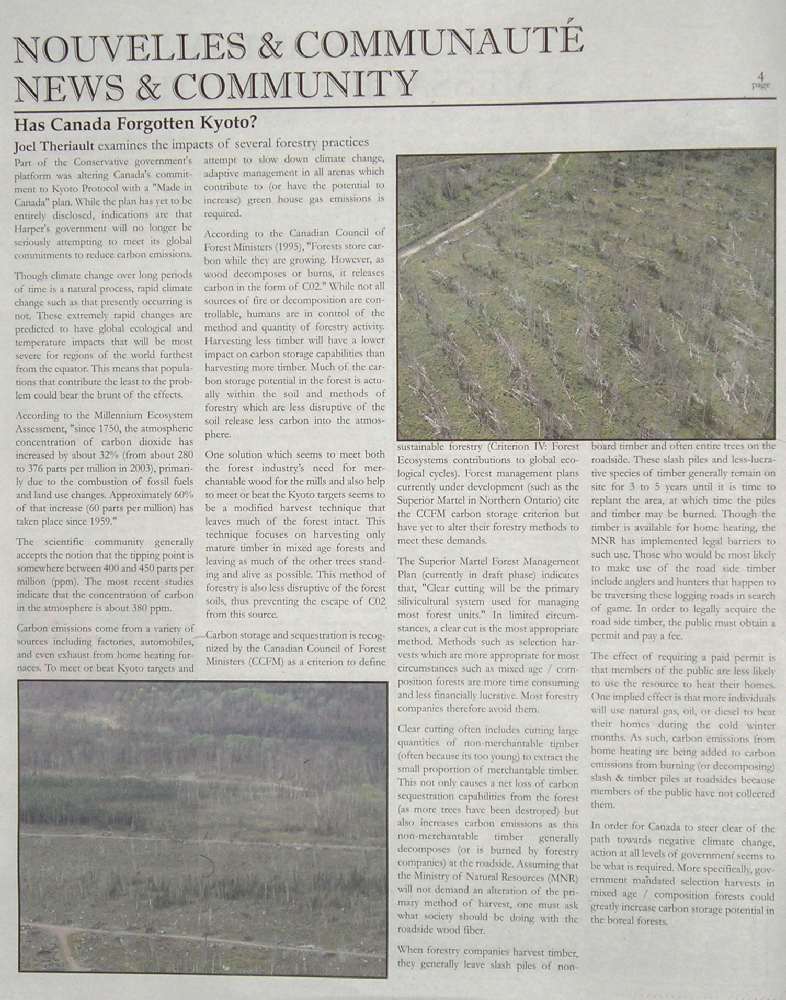
An examination of forestry impacts
Author : Joel Theriault
Written for Inter Pares Newspaper February 2006
Part of the Conservative government's platform was that it would alter Canada's commitment to Kyoto with a "Made in Canada" plan. While the plan has yet to be entirely disclosed, the indications are that Harper's government will no longer be seriously attempting to meet its global commitments to reduce carbon emissions.
Though climate change (caused in large part by Carbon Dioxide CO2) over long periods of time is a natural process, rapid climate change such as that presently occurring is not. These extremely rapid changes in climate are predicted to have global ecological impacts, and temperature impacts most severe for regions of the world furthest from the equator. Thus, the Inuit of the far north who have contributed the least to the problem of climate change are expected to be among those to bear the greatest burden of our global carbon emissions. Impacts such as higher ocean levels could wipe away ocean communities around the world, or even entire islands that are not more than a couple meters above sea level. Especially troubling for the potential of reversing warming trends is that warming the north will itself cause heating issues as the methane gas held under the perma-frost is released. Melting ice caps will mean that less sunlight is being reflected from the white surface and more being absorbed by the oceans. The list by no means ends there.
According to the Millennium Ecosystem Assessment, "Since 1750, the atmospheric concentration
of carbon dioxide has increased by about 32% (from about 280 to 376 parts per million in
2003), primarily due to the combustion of fossil fuels and land use changes. Approximately 60%
of that increase (60 parts per million) has taken place since 1959."
The scientific community generally accepts the notion that tipping point, or point of "dangerous" green house gas levels is somewhere between 400 and 450 parts per million (ppm). The most recent studies indicate that the concentration of carbon in the atmosphere is about 380 ppm.
It must be noted that even if all carbon emissions were stopped today, the effects of the carbon currently in the atmosphere could take hundreds or even thousands of years to settle and it would not prevent climate change. However, the longer society waits to address the issue, the more severe the impacts of climate change are expected to become.
Carbon emissions come from a variety of sources including factories, automobiles, and even exhaust from home heating furnaces. It should be noted that Canada had agreed necessary to reduce its greenhouse gas emissions by 6% below 1990 levels by the first Kyoto implementation stage 2008 - 2012. However, at the moment, it is estimated that Canada is 24% above 1990 levels.
To meet or beat Kyoto targets and attempt to slow down climate change, adaptive management in all arena's which contribute to (or have the potential to decrease) green house gas emissions is needed. The specific focus of this article is in regards to the method of harvest for mixed age / mixed composition forests and secondly, the appropriateness of fuel wood permits for fallen timber & forestry waste products.
According to the Canadian Council of Forest Ministers (1995), "Forests store carbon while they are growing. However, as wood decomposes or burns it releases carbon in the form of C02." While not all sources of fire or decomposition are controllable, humans are in control of the method and quantity of forestry activities. In general terms, harvesting less timber will have a lower impact on carbon storage capabilities than harvesting more timber. On a side note, much of the carbon storage potential in the forest is actually within the soil and methods of forestry which are less disruptive of the soil release less carbon into the atmosphere.
One solution which seems to meet the demands of industry (having merchantable wood for the mills) which also helps to meet or beat the KYOTO targets seems to be a modified harvest technique leaving much of the forest intact. This technique focuses on harvesting only mature timber in mixed age forests and leaving as much of the other trees standing and alive as possible. This method of forestry is also less disruptive of the forest soils, thus preventing the escape of C02 from this source.
Carbon storage and sequestration is recognized by the Canadian Council of Forest Ministers (CCFM) as a criterion to define sustainable forestry (Criterion IV: Forest Ecosystems contributions to global ecological cycles). Forest management plans currently under development (such as the Superior Martel in Northern Ontario) cite the CCFM carbon storage criterion but have yet to alter their forestry methods to meet these demands.
The Superior Martel Forest Management Plan (currently in draft phase) indicates that "Clear cutting will be the primary silivicultural system used for managing most forest units." In limited circumstances, such as a mature jack pine stand, a clear cut is the most appropriate method. Methods such as selection harvests which are more appropriate for most circumstances such as mixed age / composition forests (and would better meet carbon sequestration demands) are more time consuming, less financially lucrative, and thus avoided by forestry companies.
Methods of harvest which seem to ignore carbon sequestration requirements for sustainable forestry are by no means isolated to Northern Ontario.
According to the Millennium Ecosystem Assessment, "Clear cutting is the most common method of harvesting in Canada (Natural Resources Canada 1995). Clear cutting accounts for ... over 90% of all harvest within the country's boreal forest."
Clear cutting often includes cutting large quantities of non-merchantable timber (often because its too young) to extract the small proportion of merchantable timber. This not only causes a net loss of carbon sequestration capabilities from the forest (as more trees have been destroyed) but also increases carbon emissions as this non-merchantable timber generally decomposes (or is burned by forestry companies) at the roadside. Assuming that the Ministry of Natural Resources (MNR) will not demand an alteration of the primary method of harvest, one must ask what society should be doing with the roadside wood fibre.
Fuel wood permits
When forestry companies harvest timber, they generally leave slash piles of non-board timber and often entire trees on the roadside. These slash piles and less-lucrative species of timber (birch and poplar) generally remain on site for 3 to 5 years until it is time to replant the area, at which time the piles and timber maybe burned. Though the timber is available for home heating, the MNR has implemented legal barriers to such use. Those who would be most likely to make use of the road side timber include anglers and hunters that happen to be traversing these logging roads in search of game. In order to legally acquire the road side timber, members of the public must first apply for a permit and then pay a prescribed fee based on the quantity of timber which is expected to be utilized.
While the fee is not extremely high ($3.48 per cubic meter of timber), it does present an impediment to efficient use of the resource. The effect of requiring a paid permit prior to loading up the vehicle with road side timber is that members of the public are less likely to use the resource to heat their homes. One effect which can be implied is that more individuals will use natural gas, oil, or diesel to heat their homes during the cold winter months. As such, carbon emissions from home heating are being added to carbon emissions from burning (or decomposing) slash & timber piles at roadside because they have not been collected by members of the public.
If Canada truly desires to change the dangerous path towards climate change, action at all levels of government is needed. In order for the Ministry of Natural Resources to do its part, it would be sensible to make an exception to the fuel wood permits for fallen timber and forestry "waste". Government mandated selection harvests in mixed age / composition forests could also greatly increase carbon storage potential in the boreal forests.

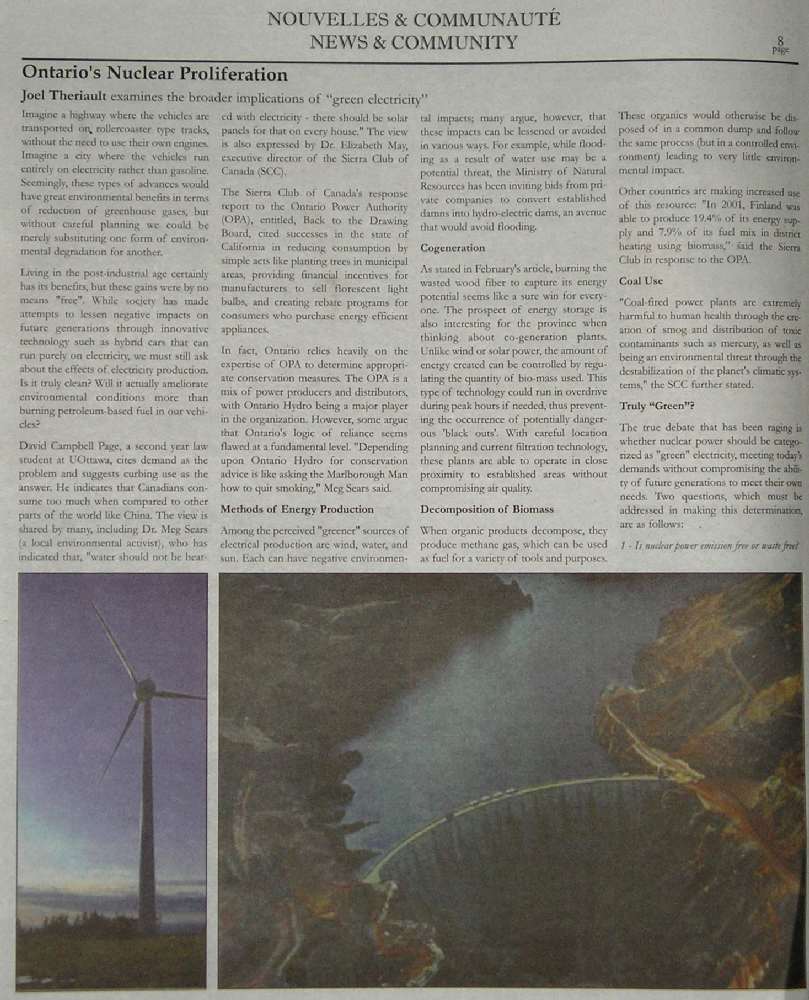
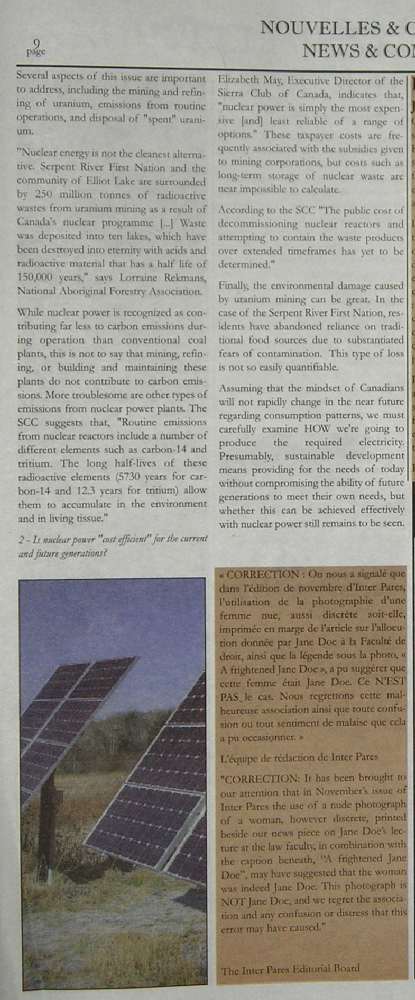
ENERGY Article
Ontario's Nuclear Proliferation ...
Joel Theriault examines Ontario Power Authority recommendations to build nuclear power plants.
Imagine a highway where the vehicles were transported on rollercoster type tracks, without the need to use their own engines. Imagine a city where the vehicles ran entirely on electricity rather than gasoline. Seemingly, these types of advances would have great environmental benefits in terms of reduction of greenhouse gases, but without careful planning we will be merely substituting one form of environmental degradation for another.
Living in the post industrial age certainly has its benefits but these gains were by no means "free". I turn on the lights when I come home after a long day of work at school. Turn on the TV to hear CNN talking about the Pope's shoes and which celebrity just got out of rehab. I take a pre-made meal of bear stew out of the freezer and warm it up in the microwave. Life is certainly much easier now than 200 years ago but these gains have not been "free". Nor have these gains negatively affected only the users standing to benefit from them. While society has made attempts to lessen the impacts on future generations by innovative technology such as hybrid cars that can run purely on electricity, we must still be asking about the effects of electricity production. Is it truly clean? Will it actually lessen the impacts on future generations more so than burning petroleum based fuel in our vehicles? Much of this answer depends on the method used for the creation of energy.
Alternatively, David Campbell Page, a second year law student at UOttawa cites demand as the problem, with Canadians being overly consumptive compared to other parts of the world like Shanghai, China. The view is shared by many including Dr. Meg Sears (a local environmental activist) indicating "water should not be heated with electricity - there should be solar panels for that on every house." The view is also radiated by Dr. Elizabeth May, executive director of the Sierra Club of Canada, as she's urging McGuinty to look deeper at conservation BEFORE signing the contracts to build a new nuclear power plant.
The Sierra Club of Canada's response report to the OPA, titled Back to the Drawing Board, cited successes in the state of California in reducing consumption by simple acts like planting trees in municipal area's, providing financial incentives for manufacturers to sell florescent lightbulbs, and creating rebate programs for consumers who purchase energy efficient appliances. The report indicates that the presence of these trees not only increased air quality but if planted in the proper locations would act to shade homes (reducing indoor temperature by as much as 15 degrees) and thereby reducing electrical consumption from air conditioning units. According to the Sacramento Municipal District, these electrical reductions are predicted to be as much as 40% when the trees reach maturity.
Interestingly enough, Ontario relies heavily on the expertise of Ontario Power Authority (OPA) to determine appropriate conservation measures. The OPA is a mix of power producers and distributors, with Ontario Hydro being a major player in the organization. However, some argue that Ontario's logic of reliance seems flawed at a fundamental level. "Depending upon Ontario Hydro for conservation advice is like asking the Marlborough Man how to quit smoking," Meg said.
Assuming that Canadians are not yet willing to reduce electrical consumption, one must look deeply into the method of electricity production which will minimize negative impacts on future generations. This is assuming that we are trying to manage the province and country for the needs of today and tomorrow. Its been suggested by the OPA that Ontario invest in nuclear power to supply the consumption needs of Ontarians. Its helpful to briefly discuss some of the different methods for energy production as well as some of their negative environmental effects.
Among the perceived "greener" sources of electrical production are wind, water, and solar. Each can have negative environmental impacts but these impacts can largely or entirely be mitigated.
Solar - According to the OPA, the two biggest environmental threats from solar panels are the possibility of leaching heavy metals during operation and disposal of batteries. However, the Sierra Club of Canada in their response to the OPA report indicates that the solar panels are sealed and therefore incapable of leaching and also that the units can be directly hooked up to the electric grid, thereby avoiding the need for any batteries.
Water - Though some working models of ocean buoys able to capture kinetic / mechanical energy exist, most of the focus regarding water power is still hydro-electric. However, creation of new dams often means flooding valleys and permanently altering the landscape. Additionally, the flooding frequently increases the levels of mercury in the water to dangerous levels, forcing some northern communities to largely abandon traditional food sources in fear of medical repercussions.
However, the Sierra Club of Canada believes that hydro power without major flooding is wholly appropriate, especially so where there are already dams installed for flood control. This approach is also consistent with that taken by the Ministry of Natural Resources as they have been inviting bids from private companies to convert established dams into hydro-electric dams. The OPA did not include the potential to upgrade existing dams in their estimate for potential electrical production capabilities.
Wind - "In addition to being an environmentally-friendly renewable resource with zero emissions, wind power has no fuel costs and therefore offers long-term price stability." - SCC response to the OPA. Access roads, generating stations, and electrical transmission lines are cited as environmental impacts by critics of wind power generation. The Sierra Club of Canada recommends installing wind power along the shoreline and in the shallow offshore waters of the great lakes. However, this decision could negatively impact fish habitat just as access roads could impact land based animals.
Two less commonly perceived sources of energy production, both seemingly "green" sources of electrical production are co-generation and decomposition of biomass.
Cogeneration - As stated in February's article, burning the wasted wood fibre to capture its energy potential seems like a sure win for everyone. The prospect of energy storage is also interesting for the province when thinking about co-generation plants. Unlike wind, water, biomass, or solar power ... the amount of energy created can be controlled by regulating the quantity of bio-mass used. This type of technology could run in overdrive during peak hours if needed, thus preventing the occurrence of potentially dangerous 'black outs'.
Decomposition of Biomass - When organic products decompose, they produce methane gas which can be used as fuel for a variety of tools / purposes. These organics would otherwise be disposed of in a common dump, and follow the same process (but in a controlled environment) leading to very little environmental impacts. One thing that is certain is that other countries are making increased use of this resource.
"In 2001, Finland was able to produce 19.4% of its energy supply and 7.9% of its fuel mix in district heating using biomass." - SCC response to the OPA.
Coal power is widely recognized as the least environmentally friendly method of electrical production.
Coal - "Coal-fired power plants are extremely harmful to human health, through the creation of smog and distribution of toxic contaminants such as mercury, as well as being an environmental threat through the destabilization of the planet’s climatic systems." SCC response report to the OPA.
The true debate which has been raging is whether nuclear power should be categorized as "green" electricity, meeting the demands of today without compromising the ability of future generations to meet their own needs. Two questions which must be addressed in making this determination are as follows.
1 - Is nuclear power emission free or waste free?
Several aspects of this issue are important to address including the mining and refining of uranium, emissions from routine operations, and disposal of "spent" uranium.
"Nuclear energy is not the cleanest alternative. Serpent River First Nation and the community of Elliot Lake are surrounded by 250 million tonnes of radioactive wastes from uranium mining as a result of Canada's nuclear programme... Waste was deposited into ten lakes, which have been destroyed into eternity with acids and radioactive material that has a half life of 150,000 years." - Lorraine Rekmans, National Aboriginal Forestry Association
While nuclear power is recognized as contributing far less to carbon emissions during operation than conventional coal plants, this is not to say that mining, refining, or building and maintaining these plants do not contribute to carbon emissions. More troublesome are other types of emissions from nuclear power plants.
The SCC indicates that ,"Routine emissions from nuclear reactors include a number of different elements such as carbon-14 and tritium. The long half-lives of these radioactive elements (5730 years for carbon-14 and 12.3 years for tritium) allow them to accumulate in the environment and in living tissue."
Problems of what best to do with the nuclear waste after its energy production capabilities have expired have yet to be resolved.
2 - Is nuclear power "cost efficient" for the current population or future populations?
Elizabeth May, Executive Director Sierra Club, indicates that ,"Nuclear power is simply the most expensive least reliable of a range of options."
These taxpayer costs are frequently associated with the subsidies given to mining corporations, but costs such as long term storage of nuclear waste are near impossible to calculate.
"The public cost of decommissioning nuclear reactors and attempting to contain the waste products over extended timeframes has yet to be determined," according to the SCC.
On a different tangent, the financial costs of loosing other values, like clean water and edible wildlife, is also near impossible to assess. This difficulty has been recognized by many including Chief Earl Commanda of the Serpent River First Nation, a former location of intense uranium mining. "[h]ow do you make the companies recognize that they did essentially destroy a way of life of a community, from being a community that lived off the land to one where that's no longer possible for us. How do you put a dollar value on that?" (p. 15 - This is my Homeland).
Assuming that the mindset of Canadians will not rapidly change in the near future regarding consumption patterns, we must carefully examine HOW we're going to produce the required electricity. Presumably, sustainable development means providing for the needs of today without compromising the ability of future generations to meet their own needs. Does nuclear power truly meet the requirement of sustainable development when the alternatives are more fully considered?